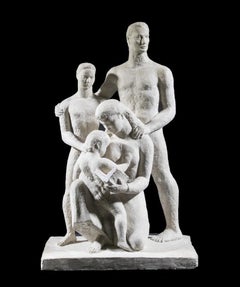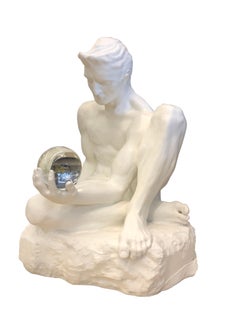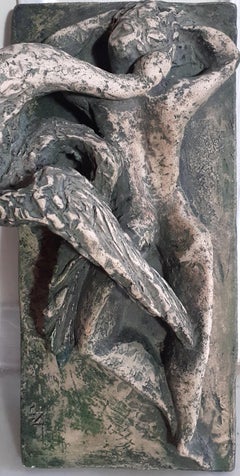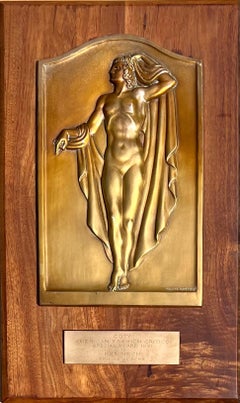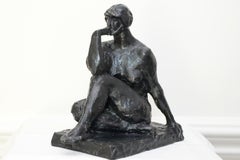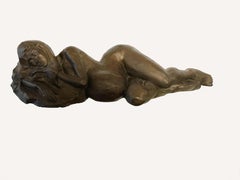Plaster Nude Sculptures
to
1
1
2
1
Overall Width
to
Overall Height
to
4
1
1
1
1
5
4
1
1
1
4
3
2
2
1
1
1
1
1
1
5,265
54
53
17
13
1
1
3
1
Style: Modern
Medium: Plaster
"Pioneer Family" WPA American Modernism Plaster Maquette Realism 20th Century
Located in New York, NY
"Pioneer Family," 23 1/2 x 16 1/4 x 10 3/4 inPlaster. c. 1927. Unsigned. Realism
The Smithsonian has a cast of this sculpture in its collection. Pictured on the cover of “The Sculpt...
Category
1920s American Modern Plaster Nude Sculptures
Materials
Plaster
Nude Man Figure Holding Crystal Ball
Located in Lake Worth Beach, FL
Nude Man Holding Crystal Ball White Sculpture
Modern cement, plaster, clay sculpture of a man holding crystal ball painted white, Signature not found.
Ab...
Category
1980s Modern Plaster Nude Sculptures
Materials
Plaster, Acrylic, Clay, Glass
$1,480 Sale Price
45% Off
Leda and the Swan modernist mid century sculpture by French woman artist
Located in Norwich, GB
A unique piece: a hand modelled sculpture by French artist Jeannine Nathan (b.1924). Working in Paris, Jeannine was able to visit Picasso’s studio, and was impressed by the
Master’s ...
Category
1960s Modern Plaster Nude Sculptures
Materials
Plaster
2 Sculptures: "The Power" & "The Glory" WPA Depression WWII era mid 20th century
Located in New York, NY
2 Sculptures: "The Power" & "The Glory" WPA Depression WWII era mid 20th century by Agnes Yarnall circa 1940s.
Sculptor, painter, poet and artistic historian, Agnes Yarnall has, since the age of six been breathing life into her art.
Renowned as a sculptor, whose commissioned portrayals of contemporary celebrities are prized. She has sculpted Judith Anderson, Edna St. Vincent Millay, Carl Sandburg...
Category
1940s American Modern Plaster Nude Sculptures
Materials
Plaster
Related Items
1961 Coty Award Plaque Kenneth Hairdresser Jacqueline Onassis Bronze Fashion
Located in New York, NY
1961 Coty Award Plaque Kenneth Hairdresser Jacqueline Onassis Bronze Fashion
Bronze on wood. The wood plaque measures 12 3/4" by 20 3/4 inches. The bronze plaque itself is 13 3/4 x 8 3/4 inches and the the bronze inscription, which reads "COTY, American Fashion Critics Special Award 1961 to KENNETH of LILY DACHE...
Category
1960s American Modern Plaster Nude Sculptures
Materials
Bronze
Woman Seated A Bronze Sculpture of a Woman by Charles Rumsey
Located in Brookville, NY
The bronze sculpture of a woman by Charles Rumsey is undated, but was created at a point in his career where he began to transition from realism to more modern, looser depictions of ...
Category
1920s American Modern Plaster Nude Sculptures
Materials
Bronze
$6,000
H 10.5 in W 11 in D 6 in
Seated Nude Woman Sculpture, Early 20th Century
Located in Beachwood, OH
William Zorach (American, 1887-1966)
Seated Woman
Painted plaster
Inscribed underside "V"
12.5 x 9 x 5 inches
Provenance: The Tatti Family Collection
Bill Zorach was born in Lithuan...
Category
Early 20th Century Plaster Nude Sculptures
Materials
Plaster
The weight of your head.…", Porcelain Cup with Sgraffito Detailing
Located in Miami Beach, FL
This cup is one of 48 that make up the installation, “Fragments of Our Love Story.” These cups feature feminine forms which recall the Venus of Willendorf and other historical fertil...
Category
2010s Modern Plaster Nude Sculptures
Materials
Ceramic, Clay, Porcelain, Paint, Underglaze
$200
H 4 in W 3 in D 3 in
Mother Goddess Figurine, Early Indus Valley Civilization (circa 3500 - 2800 BC)
Located in Paris, Île-de-France
Mother Goddess Figurine
Early Indus Valley Civilization (circa 3500 - 2800 BC)
Handmade pottery, 140 mm x 45 mm, 60 g
Provenance:
Prince Collection, 1990s-2014;
Pierre Bergé Colle...
Category
15th Century and Earlier Tribal Plaster Nude Sculptures
Materials
Clay, Terracotta
$5,294 Sale Price
40% Off
H 5.52 in W 1.78 in D 0.79 in
Harmony, 20th century bronze & green marble base, nude man and woman with lyre
By Max Kalish
Located in Beachwood, OH
Max Kalish (American, 1891-1945)
Harmony, c. 1930
Bronze with green marble base
Incised signature on right upper side of base
14 x 9 x 5 inches, excluding base
17 x 10 x 8 inches, including base
Born in Poland March 1, 1891, figurative sculptor Max Kalish came to the United States in 1894, his family settling in Ohio. A talented youth, Kalish enrolled at the Cleveland Institute of Art as a fifteen-year-old, receiving a first-place award for modeling the figure during studies with Herman Matzen. Kalish went to New York City following graduation, studying with Isidore Konti...
Category
1930s American Modern Plaster Nude Sculptures
Materials
Marble, Bronze
$10,450
H 17 in W 10 in D 8 in
Pair of 19th century scagliola sculptures (Italian Neoclassicism) - Roman figure
Located in Varmo, IT
Pair of scagliola sculptures - Roman figures. Italian manufacture, 19th century.
51 x 26 x h 118 cm (left) - 41 x 28 x h 118 cm (right).
Made entirely of scagliola. Depicting two f...
Category
Early 19th Century Old Masters Plaster Nude Sculptures
Materials
Plaster
$5,776 Sale Price
20% Off
H 46.46 in W 20.08 in D 10.24 in
Seated Female Nude, circa 1930-1940, Giorgio Rossi (1894–1981), Tuscan sculptor
Located in Firenze, IT
Seated Female Nude, circa 1930-1940, Giorgio Rossi (1894–1981), Tuscan sculptor
Period: circa 1930-1940
Artist: Giorgio Rossi (1894–1981)
This sculptu...
Category
1930s Plaster Nude Sculptures
Materials
Clay, Terracotta
$2,153
H 14.97 in W 17.72 in
Life-size Plaster Statue of The Callipygian Venus or Aphrodite 1920'
Located in Rome, IT
Italian life-size plaster sculpture , figure of the Callipygian Venus, after the antique Roman marble statue.
Aphrodite Kallipygos, or Callipygian Venus literally means “Venus of ...
Category
1920s Academic Plaster Nude Sculptures
Materials
Plaster
$8,664 Sale Price
20% Off
H 70.87 in Dm 23.63 in
Cold Cast Bronze Bust Sculpture of Vincent Van Gogh by British Sculptor Artist
Located in Preston, GB
Cold Cast Bronze Bust Sculpture of Vincent Van Gogh by British Artist & Sculptor Anthony D Padgett BA MA PGDip, Born in 1969.
Everyone has an idea o...
Category
2010s Contemporary Plaster Nude Sculptures
Materials
Cast Stone, Metal, Bronze
$5,510 Sale Price
20% Off
H 14 in W 9 in D 7 in
Nude Walking, Early 20th Century Bronze Sculpture, Cleveland School Artist
By Max Kalish
Located in Beachwood, OH
Max Kalish (American, 1891-1945)
Nude Walking, 1930
Bronze
Signed and dated on base
17 x 9 x 4 inches
Born in Poland March 1, 1891, figurative sculptor Max Kalish came to the United States in 1894, his family settling in Ohio. A talented youth, Kalish enrolled at the Cleveland Institute of Art as a fifteen-year-old, receiving a first-place award for modeling the figure during studies with Herman Matzen. Kalish went to New York City following graduation, studying with Isidore Konti and Herbert Adams...
Category
1930s American Modern Plaster Nude Sculptures
Materials
Bronze
$8,125
H 17 in W 9 in D 4 in
My favorite moment.., Porcelain Cup with Sgraffito Detailing
Located in Miami Beach, FL
This cup is one of 48 that make up the installation, “Fragments of Our Love Story.” These cups feature feminine forms which recall the Venus of Willendorf and other historical fertil...
Category
2010s Modern Plaster Nude Sculptures
Materials
Ceramic, Clay, Porcelain, Paint, Underglaze
$200
H 4.5 in W 3 in D 3 in
Previously Available Items
"Symbiosis" Original Plaster Cast Sculpture by Natalie Krol
Located in Pasadena, CA
This sculpture by Natalie Krol is made of plaster with a beautiful bronze color finish. It is the cast for the bronze.
It shows a nude, pregnant woman resting. The expression on her ...
Category
Mid-20th Century Modern Plaster Nude Sculptures
Materials
Plaster
H 6 in W 24.5 in D 8.5 in
Industrial Machine Age American Scene WPA Mid 20th Century 1939 SF World's Fair
Located in New York, NY
Industrial Machine Age American Scene WPA Mid 20th Century 1939 SF World's Fair
HAIG PATIGIAN (American/Armenian, 1876-1950)
Aeronautics Pediments
Two Plaster Casts, c. 1930s
each 13.25 x 14.75 x 6 inches
It's possible these moquettes were created for the 1939 World's Fair, the Golden Gate International Exhibition in San Francisco.
Provenance: Private Collection of Lois M. Wright, Author of "A Catalogue of the Life Works of Haig Patigian, San Francisco Sculptor, 1876-1950),” 1967
Loan to Oakland Museum of California (Oakland, CA)
BIO
Haig Patigian is noted for his classical works, which are especially numerous in public venues in San Francisco, California. Patigian was born in Van, Armenia, which at that time was under Turkish rule. Haig was the son of Avedis and Marine Patigian, both teachers in the American Mission School there. He and his older brother showed an aptitude for art early on and were encouraged by their parents. Their father himself had taken up the new hobby of photography. The 1880s were harsh times, however, for many Armenians under an oppressive rule by the Turkish government. Many people were fleeing to the safety of the United States. Suspicious Turkish authorities accused his father of photographing city structures for the Russian government, and in 1888 he fled for his life to America.
Haigs father made his way to Fresno, California, and began life anew as a ranch hand. Within two years he sent for his wife, as well as Haig, his three sisters and brother, and in 1891 the Patigians made the journey from Armenia. Haigs father, an industrious man, worked on various farms, and eventually bought his own ranch and vineyard. It was among fertile farmland of Fresno that Haig grew up.
Young Haigs education consisted of teachings by his parents and by intermittent attendance in public schools. Although he had dreams of becoming an artist, he did not have the opportunity for formal study of art, and began working long days in the vineyards around Fresno.
At age seventeen, Haig made a step towards his dreams and apprenticed himself to learn the trade of sign painting. In his spare time he nurtured his interest in art by painting nature and life scenes with watercolors and oil paints. When his sign-painting mentor left Fresno, Haig opened his own shop and made a name for himself in the town. San Francisco, in the meantime, had been attracting artists since the Gold Rush and had become a thriving art center. Within a few years, Haig had put aside several hundred dollars to move to San Francisco, joining his brother who was already working there as an illustrator.
In 1899, when he was twenty-three, Haig had saved enough money to enroll at the Mark Hopkins Art Institute in San Francisco. Like many aspiring artists of his time, Patigian supported himself by working as a staff artist in the art department of a local newspaper, and in the winter of 1900, nearing his 24th birthday, Haig began work for the San Francisco Bulletin, producing cartoons, black and white illustrations, as well as watercolors.
In 1902 tragedy struck Haig and his family. His 29-year-old brother died of pneumonia, and then his frail mother died a short time later. Five months more saw his youngest sister, just out of high school, die too. Saddened and depressed, Haig moved out of the studio he had shared with his brother, and into a dilapidated studio in a poor section of town. During this time of sadness, Haig fed a growing interest in sculpture.
In 1904 Haig created what he later called his "first finished piece in sculpture". The work, called "The Unquiet Soul", depicted a man thrown back against a rock while waves lash at his feet. The body was tense and twisted, with one hand, in Haig's own words, "searchingly leaning and clutching the rock, while the other masks his troubled head".
The Press Club of San Francisco, which Haig had joined in 1901, put "The Unquiet Soul" on exhibition and local headlines proclaimed "Local Newspaper Artist Embraces Sculptor's Art", and "First Work Predicts Brilliant Future". With the support of friends and community acclaim, the young illustrator left his newspaper job and became a professional sculptor.
The path of his new career was not easy though. Haig had never made much money working for the newspaper and his father needed help with growing debt from funeral expenses and business problems. From time to time Haig sold some artwork, but also occasionally borrowed from friends to pay the rent. He was the classic 'starving artist'.
In the spring of 1905 a white-bearded 81-year-old stranger knocked on Haig's door. It was George Zehndner, from Arcata, California. Zehndner had been born in Bavaria, Germany in 1824, the son of a farmer. In 1849 he had come to America looking for prosperity, settling in Indiana, where he worked on a farm and learned English. He found his way to the West Coast in 1852. Penniless, he worked in various jobs from San Francisco to Sacramento, then found some luck working in the gold fields of Weaverville in Trinity County, and eventually moving to a farm on 188 acres near Arcata. In his 77th year in May of 1901, Zahndner had taken a trip to San Jose, where he stood in a crowd to see a man he thought much of, President William McKinley. McKinley was popular as 'the first modern president' partially because he realized going out to meet the common person increased his support. In September of that year, however, an anarchist assassinated the president while he stood in a receiving line at the Pan-American Exhibition in Buffalo, New York. Soon after, the city of San Jose erected a statue of the slain president in St. James Park. Zehndner took a second trip to San Jose where he visited the McKinley monument. Touched, Zehndner decided that, no matter the cost, his town of Arcata too would memorialize McKinley.
George Zehndner had read about Haig in a newspaper article and asked if Patigian would create a heroic statue of the late President McKinley for Arcata. When asked how much it would cost, Haig responded, despite his borderline poverty, with the fabulous sum of $15,000. Zehndner agreed. The President was to be portrayed standing, wearing an overcoat, with his feet planted squarely on the ground. In the finished statue, one hand is held out before him in a typical posture of speaking, with the other hand holding the speech as his side. The 9-foot statue...
Category
1930s American Modern Plaster Nude Sculptures
Materials
Plaster
Lucienne, Mid 20th Century Sculpture.
Located in Cotignac, FR
French Mid Century patinated plaster statue by Joseph Rivière. Possibly a maquette for a project in bronze. The work is signed in full on the base of the plaster (see photo), partly obscured by the marble stand.
The statue is a wonderful graphic representation of a woman in acrobatic pose with stylised head and limbs. The statue presents a whole new interpretation of the subject from each angle. Rivière took much inspiration from his wife when creating his female nudes.
Stylistically the sculpture is similar in style to his work 'Gisant' of 1949.
Joseph Rivière was born in Tours on 5 April 1912. His father was Michel Rivière, a career soldier who was transferred to Bordeaux two months after the birth of his son. Joseph attended the Lycée Michel Montaigne in Bordeaux for his secondary education. He attended the École des Beaux-Arts of Bordeaux, and studied sculpture under Charles Louis Malric from 1930–33. He also studied drawing under François-Maurice Roganeau...
Category
Mid-20th Century Modern Plaster Nude Sculptures
Materials
Marble
Reclining Nude
By Henry Moore
Located in Wien, Wien
Henry Moore
Castleford 1898 - 1986 Much Hadham
and Studio
Reclining Nude ca. 1983
Bozzetto in Plaster on oak wood base
19 x 11 cm
Numbered on the underside
Category
1980s Modern Plaster Nude Sculptures
Materials
Plaster
Plaster nude sculptures for sale on 1stDibs.
Find a wide variety of authentic Plaster nude sculptures available on 1stDibs. While artists have worked in this medium across a range of time periods, art made with this material during the 21st Century is especially popular. There are many well-known artists whose body of work includes ceramic sculptures. Popular artists on 1stDibs associated with pieces like this include Sidonie Laurens, Peter Brooke, Bruno Innocenti, and Charles Despiau. Frequently made by artists working in the Contemporary, Modern, all of these pieces for sale are unique and many will draw the attention of guests in your home. Not every interior allows for large Plaster nude sculptures, so small editions measuring 1.5 inches across are also available
Recently Viewed
View AllMore Ways To Browse
Robert Hamilton Painting
Robert Roche Saratoga
Robert Schlegel
Robert Sword
Robert Wood Winter Landscapes
Rogiers Painting
Roland Davies
Roland Knight
Romantic Couple Walking Painting Peter
Ronnie Scotts London
Rose Cameron
Rossini Oil Painting
Rossini Oil
Russian Naked
S Lucas Painting
Sag Harbor Ny Prints
Salman Toor
Samuel Carter
